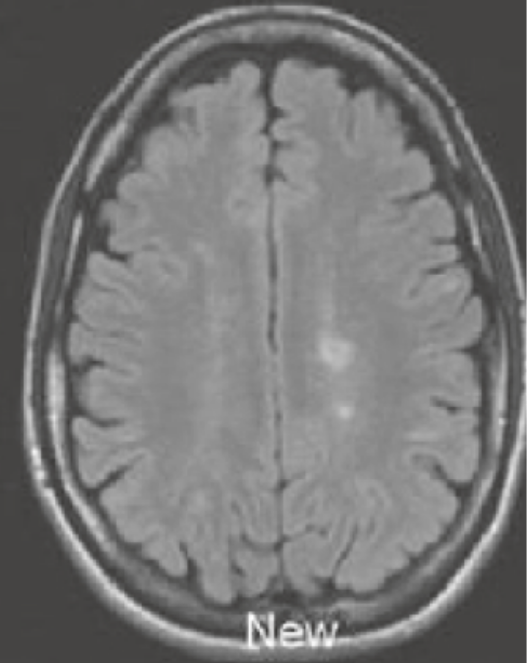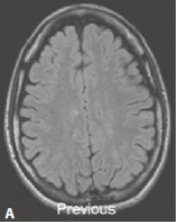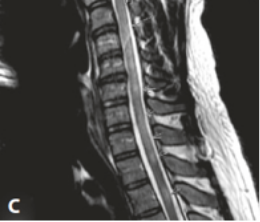
IDENTIFYING PATIENT TRANSITIONS IN MULTIPLE SCLEROSIS
John,* 28 Years
Diagnosed with RRMS in 2008
An IT consultant who was initially diagnosed after an episode consistent with a partial transverse myelitis, bilateral paresthesias in the extremities, with positive Lhermitte's sign. John is currently on disease modifying therapy.
What is John's current Diagnosis?
Patient Notes*
Expanded Disability Status Scale (EDSS)2

Sustained progression of disease is predicted by a minimum score of 4,3 and an increase in EDSS score of at least one point (for scores ≤5.5), measured over two time points, at least three months apart.4
Patient Notes*
Relapses
-
Two relapses in the past year
-
Symptoms during last relapse:
-
Muscle weakness
-
Mobility issues
-
Tingling in the extremities
-
Bladder incontinence
-
Current Symptoms
-
Worsening fatigue
-
Worsening mobility
-
Bladder incontinence
Functioning
Symptoms have had moderate impact on
mobility, social activities, and work
Time will tell, I guess. I know that the therapies also slow down progression. I've only been on my current treatment for just over a year, and I realize that there is the possibility of another relapse, but I feel that now I'm getting the right treatment, I'll be able to tackle it effectively—now that we know what's going on.1**
**Actual patient testimonial.
Patient History*
Clinical data6 from 6 months ago
Evoked potentials
- Abnormal (prolonged) lower limb somatosensory evoked potentials (SSEPs)
T25FW7,8
4.5
Modified Fatigue Impact Scale9,10
40
total score
Brain MRI
FLAIR MRI showing a few diffuse lesions in the periventricular area
Permission granted by Springer International Publishing11 |
Spinal MRI
Multiple cervical T2 lesions
Permission granted by Springer International Publishing11 |
Current Test Results*
Current results
Evoked potentials
- Abnormal (prolonged) lower limb somatosensory evoked potentials (SSEPs)
T25FW7,8
 5.5
5.5
Modified Fatigue Impact Scale9,10
 45
45
Brain MRI
FLAIR MRI showing a few diffuse lesions in the periventricular area
Permission granted by Springer International Publishing11 |
Spinal MRI
Multiple cervical T2 lesions`
Permission granted by Springer International Publishing11 |
*Not a real patient.
EDSS, Expanded Disability Status Scale; FLAIR, fluid-attenuated inversion recovery; MRI, magnetic resonance imaging; RRMS, relapsing-remitting multiple sclerosis; SSEP, somatosensory evoked potential; T25FW, timed 25-foot walk.
References
-
Burtchell J, Fetty K, Miller K, Minden K, et al. Two sides to every story: Perspectives from four patients and a healthcare professional on multiple sclerosis disease progression. Neurol Ther. 2019;8:185-205.
-
Kurtzke JF. Rating neurologic impairment in multiple sclerosis: An expanded disability status scale (EDSS). Neurology. 1983;33(11):1444-1452.
-
Lorscheider J, Buzzard K, Jokubaitis V, et al. Defining secondary progressive multiple sclerosis. Brain. 2016;139(Pt 9):2395-2405.
-
Kalincik T, Cutter G, Spelman T, et al. Defining reliable disability outcomes in multiple sclerosis. Brain. 2015;138(Pt 11):3287-3298.
-
Luzzio C. Multiple sclerosis. Accessed March 13, 2020. https://emedicine.medscape.com/
article/1146199 -
Tur C, Moccia M, Markhof F, et al. Assessing treatment outcomes in multiple sclerosis trials and in the clinical setting. Nat Rev Neurol.
2018;14(2):75-93. -
Fischer JS, Jak AJ, Kniker JE, et al. Multiple Sclerosis Functional Composite (MSFC). Accessed March 29, 2020. Administration and Scoring Manual. https://www.nationalmssociety.org/
NationalMSSociety/media/MSNationalFiles/
Brochures/10-2-3-31-MSFC_Manual_and_Forms.pdf -
Phan-Ba R, Pace A, Calay P, et al. Comparison of the timed 25-foot and the 100-meter walk as performance measures in multiple sclerosis. Neurorehabil Neural Repair. 2011;25(7):672-679.
-
Ritvo PG, Fischer JS, Miller DM, et al. Multiple Sclerosis Quality of Life Inventory: A User’s Manual. National Multiple Sclerosis Society. New York, NY:1997;47-49. Accessed March 27, 2020. https://www.nationalmssociety.org/For- Professionals/Researchers/Resources-for- Researchers/Clinical-Study-Measures/Multiple- Sclerosis-Quality-of-Life-Inventory-(MSQL
-
Hadjimichael O, Vollmer T, Oleen-Burkey M. Fatigue characteristics in multiple sclerosis: The North American Research Committee on Multiple Sclerosis (NARCOMS) survey. Health Qual Life Outcomes. 2008;6:100.
-
Eckstein C. Established relapsing-remitting multiple sclerosis. In: Giacomini PS, ed. Case Studies in Multiple Sclerosis. Springer International Publishing; 2017:35-57.
-
Multiple Sclerosis Trust. Describing fatigue to others. Accessed March 6, 2020. https:// www.mstrust.org.uk/news/views-and-comments/ describing-fatigue-others
-
Benedict RHB, DeLuca J, Phillips G, et al. Validity of the Symbol Digit Modalities Test as a cognition performance outcome measure for multiple sclerosis. Mult Scler J. 2017;23(5):721-733.
-
Zivadinov R, Bakshi R. Role of MRI in multiple sclerosis II: Brain and spinal cord atrophy. Front Biosci. 2004;9:647-664.
-
Science Photo Library. Accessed March 30, 2020. https:www.sciencephoto.com/media/779202/view




